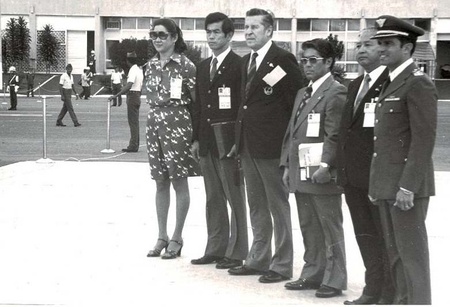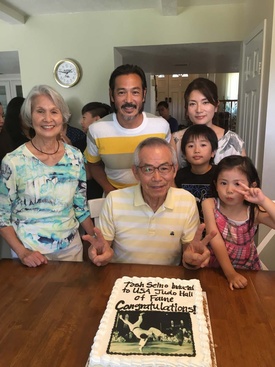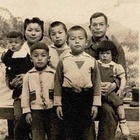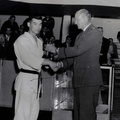Working at an airport often meant no weekends. Then in 1966, their son was born, and Toshiyuki and his wife Midori's lives became busier all at once. Even so, Toshiyuki would go out to the garden and continue practicing judo alone whenever he had time. In 1967, the World Championships were held in Salt Lake City, and Toshiyuki, representing the United States, placed fourth. "The last time I competed in a tournament was in 1970. I was 30 then." At his last US National Championships, he placed second in his weight class, finishing on a high note. After that, he taught the next generation of judo instructors at dojos all over the country.
Meanwhile, at Japan Airlines (JAL), where he started working at the counter, Toshiyuki, who was familiar with both Japanese and American languages and cultures, quickly rose to prominence and was given important positions. In 1978, to commemorate the 70th anniversary of Japanese immigration to Brazil, the Crown Prince and Princess visited Brazil. Two JAL planes were chartered for the visit, and Toshiyuki was selected as one of the staff members who waited at each destination and arranged for the visit to go smoothly.
"I flew from LA to Miami and then on to Brazil. I would arrive ahead of time before the plane landed and prepare the in-flight meals and such. When I was in Sao Paulo, I happened to meet some members of my mother's family who had immigrated there, and I remember going over and having a meal with them."
The head of JAL's San Francisco branch, who was one of the staff supporting the visit of the Crown Prince and Princess, noticed Toshiyuki's work. "After I came back to Los Angeles, he said to me, 'The head of the San Francisco branch wants you to come. What would you do?' So Toshiyuki said, 'Sure.'" Toshiyuki answered lightly, but Midori says that there was a bit of a commotion at home.
"My son is in the eighth grade and doesn't want to be separated from his friends. He also loves the ocean, but when we arrived in San Francisco and took him to the beach, there was so much fog that you couldn't see a thing (laughs)."
After working in San Francisco for a total of 12 years, Toshiyuki was unexpectedly offered the position of branch manager at Chicago airport. "Until then, all the airport branch managers had come from Japan, and it was the first time that a non-Japanese person had become an airport branch manager in the United States," says Toshiyuki. The Chicago flight, which had previously been three times a week, became a daily flight in 1989. Midori, who worked in accounting, followed Toshiyuki, and Toshiyuki moved to Chicago first.
When I asked Midori if she had any worries when she moved to America, where her husband lives, from Los Angeles to San Francisco and then to Chicago, she replied with a cheerful smile, "It was tough at the time, but I had a lot of fun experiences at each place we moved to." "I guess you could say that the years just flew by while we were busy. I thought I would do something after my children were grown, so I went to San Francisco and attended adult school and college to study accounting. Toshiyuki told me not to work for a Japanese company, so I just looked for jobs through newspaper classified ads."
As their seven-year life in Chicago drew to a close, the couple were planning to retire and take a road trip to Los Angeles. "Then, someone asked me, 'The branch manager of the Los Angeles airport is going back to Japan, so why don't you come back to Los Angeles one more time?'" Toshiyuki returned to Los Angeles in September 1997 and worked for JAL for 37 years until he retired in 2002. During that time, the Japanese economy experienced its ups and downs, including Japan's high economic growth, Japanese companies' overseas expansion, and the collapse of the bubble economy. At times, Japanese customers were unreasonable due to their economic power, but while respecting the customers, Toshiyuki, like his sharp and agile attitude, would always say what he had to say when it was time to.
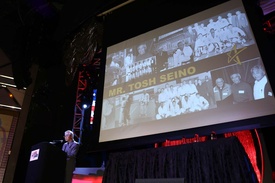
Since returning to Los Angeles in 1997, Toshiyuki has taught judo as a technical advisor at the Gardena Judo Club, and since retiring in 2002, he has also held judo clinics at the request of dojos throughout California. In 2019, he will be inducted into the USA Judo Hall of Fame, which honors those who have made significant contributions to the world of judo, along with eight other judokas. Only 22 people have received this honor to date.
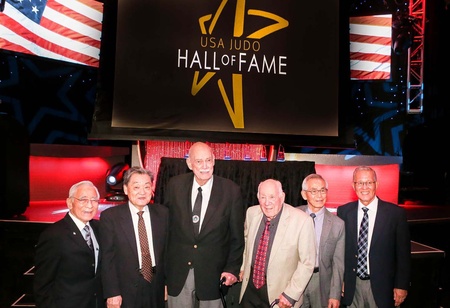
As you know, the COVID-19 pandemic occurred in 2020, and most face-to-face activities were suspended in Los Angeles. During that time, Toshiyuki continued to teach judo via Zoom. He also talks to his son and his family who live in Japan via Zoom. "My son moved to Japan after graduating from school in the United States. As a child, I used to take him back to my parents' home in Hiroshima every summer vacation, so he grew to love Japan, joined a Japanese company, found a wonderful wife in Japan, and is blessed with two children and building a happy family," Midori said.
From Los Angeles to Arkansas, Tule Lake, Kagoshima, Kobe, Denver, Los Angeles, South Carolina, Los Angeles again, Arizona, Los Angeles, San Francisco, Chicago, and Los Angeles.... Toshiyuki has moved around a lot, built a life there, and practiced judo. "I thought it was normal to go back and forth, and I thought it was something I could move around easily, and the pandemic messed me up." He said he hasn't been to Japan for more than three years. "I hope I can go this year."
However, Toshiyuki is busy in Los Angeles. In addition to judo, he is also active as a director of ASA, an organization that Midori has been involved in, and the Kaseda-kai, of which he serves as chairman, will celebrate its 100th anniversary in 2024. "My parents' hometown, Tsunuki, is in Kaseda City, Kagoshima, and there are quite a few people from the surrounding area who come to America." The Kaseda-kai is a gathering of people with roots in Kaseda and the surrounding area. "There are probably about 50 members of the Kaseda-kai right now. It's been almost 100 years since the organization was founded, so I'd like to hold a 100th anniversary celebration."
© 2022 Masako Miki



